Sommaire
Omega Constellation Vintage: History, “Pie Pan” Models, and Collector’s Guide
General Overview of the Constellation Range
Launched in 1952, the Omega Constellation collection quickly established itself as one of the flagship ranges of the Biel/Bienne manufacture. Designed from the outset as a prestigious line of chronometer wristwatches, it takes its name from the star constellations in homage to the chronometric precision records achieved by Omega in observatories. Indeed, the Constellations feature a medallion engraved with an observatory topped by eight stars on the case back, symbolizing Omega’s chronometric achievements (two records at Kew-Teddington in 1933 and 1936, and six first places at the Geneva Observatory between 1945 and 1952). Thanks to its high-quality construction and unfailing precision, the Constellation was even nicknamed “the Swiss watch” par excellence at the time.
From its origin, the Constellation occupied the high end of the Omega universe, alongside the Seamasters launched in 1948. It carried the torch from the Centenary (a limited model from 1948 celebrating Omega’s centenary) by offering mass production of a luxurious automatic watch certified as a chronometer. Omega offered various cases (steel, yellow gold, rose gold, white gold, or gold-plated steel) to suit all budgets without compromising on precision. All Constellations from the 1950s-60s thus house Omega’s best automatic chronometer calibers and were sold with the official certificate from the Geneva Observatory guaranteeing their high precision. This quest for performance meant that the Constellation was, along with Rolex, one of the most precise and renowned watches of its time. Its positioning therefore combines watchmaking prestige (award-winning chronometers) and classic elegance, which still earns it a strong following among collectors today.

The “Pie Pan” Constellations: Iconic Dials of the 1950s-60s
A first emblematic example: Omega Constellation “Pie Pan” from the 1950s in a “gold cap” version (gold-plated steel case) with a 12-facet black lacquered dial and golden hour markers. The nickname “Pie Pan” comes from the faceted shape of the dial evoking an inverted pie tin.
Among all vintage Constellations, models with the so-called “Pie Pan” dial hold a special and highly prized place. This nickname literally describes the dial with twelve sloped facets around its edge, whose convex shape resembles a pie tin seen in profile. Introduced as early as 1952 on the first solid gold Constellations (notably the Grand Luxe reference 2699), this faceted dial would become a true aesthetic signature of the range during the 1950s-60s. Designed, according to legend, by the young designer Gérald Genta, the Pie Pan dial gives the Constellations a strong visual identity while improving the readability of the hour markers.
Several distinctive features define the “Pie Pan” Constellations. First, the faceted dial itself: the central part is slightly domed and bordered by a twelve-sided sloping edge, corresponding to the hour markers. These markers, often in applied gold, are generally beveled and sometimes topped with a dot of luminescent paint (on the so-called “luminous” models with radium/tritium). At 6 o’clock, the applied five-pointed star, the symbol of the Constellation range, is systematically found. The Omega logo and the inscription “Omega Automatic Chronometer Officially Certified” appear below 12 o’clock, while the name Constellation appears in elegant cursive letters above the star. On many examples from the 1950s, a double horizontal and vertical line (called a crosshair) crosses the dial in its center, serving as a symmetry marker – a design detail appreciated by collectors. Finally, the case backs feature the famous bas-relief medallion depicting the Geneva Observatory surrounded by eight stars, a visual guarantee of the movement’s chronometric precision.
All these elements – the “pie pan” dial, golden star, harmonious text, and medallion – give the Constellation Pie Pans an aesthetic that is both luxurious and technical, immediately recognizable.
This combination of design and performance explains why Pie Pans are highly sought after by collectors today. On the one hand, they mark the pinnacle of Omega quality in the 50s-60s, with mechanical movements of remarkable reliability and precision for the time. On the other hand, their mid-century aesthetic has become iconic: the faceted dial adds relief and sophistication, within a contained diameter (around 34-35 mm) typical of the era, giving them undeniable vintage charm. Solid gold or “Grand Luxe” versions (with an integrated gold bracelet called a brick bracelet) reach very high prices due to their rarity, but even the steel or gold-plated variations are highly prized. The mention “Pie Pan” has thus become a value argument in the collector’s watch market, as these particular dials have stood the test of time without losing their appeal. In short, owning a Constellation Pie Pan means holding a piece of Omega’s watchmaking golden age, where technical excellence met highly original design.
Identifying References and Characteristics of Vintage Constellations
How to navigate the references? Omega produced numerous variations of the Constellation between the 1950s and 1970s, and each reference is distinguished by certain details of the caliber, case, or dial. Here are some keys to identifying the emblematic models:
References and Calibers: The first Constellations from 1952 (ref. 2648, 2652…) used the automatic caliber 352 or 354 with a “bumper” rotor (oscillating hammer movement) before Omega adopted a more modern central rotor in 1955-56. Thus, around 1956, references like the 2852 inaugurated caliber 501 (then 505), one of Omega’s first full-rotor automatic movements.

In 1959, Omega introduced calibers 551 (no-date version) and 561 (with date) which equipped the no-date and date Constellations respectively from the late 50s. For example, reference 14381 (introduced in 1959) houses caliber 551 and does not feature a date window, while its sibling 14393 integrates caliber 561 with a date display at 3 o’clock. These transitional models (14381/14393) mark the shift from the 50x calibers to the flatter 55x calibers, making the watch slightly thinner. In 1966, Omega evolved the date caliber by introducing the caliber 564 featuring a quick date correction (by pulling the crown), which then replaced the 561.
The 564 will be found notably in reference 168.005 on models produced after 1966. In the late 60s, Omega also offered Constellations with a day-date function using caliber 751 (e.g., ref. 168.029).
Reference Numbering: Constellations before about 1962 bear short numbers (4 or 5 digits). Around 1962-1963, Omega adopted a new 6-digit coding system with a dot (e.g., 168.005 succeeded 14393). Thus, ref. 14900 (no date) and 14902 (with date) from 1962 would be redesignated slightly later as 167.005 and 168.005 – these are essentially the same models. These references 167.005 / 168.005 (often called “dog-leg” Constellations by English speakers due to the angular shape of their lugs) are particularly well-known among enthusiasts.
They correspond to the classic “Pie Pan” Constellations of the 1960s: a round case of ~34 mm with prominent “dog-leg” shaped lugs, a 12-faceted dial (most of the time), and movement 551 or 561/564 depending on the presence of a date.
In the following years, other notable references appeared, such as the Constellations with a so-called “C-shape” case (C-shaped) introduced from 1964 (ref. 168.009, 168.010, then 168.017, etc.), or the Constellation Electronic with tuning fork and the Constellation Megaquartz in the 1970s. A summary table at the end of the article presents the specifications of the emblematic references.

Aesthetic Details and Logos: Several visual elements help recognize an authentic vintage Constellation. The Omega logo is almost always applied (metal piece attached) to the dial, as is the star at 6 o’clock. The name Constellation is inscribed in fine cursive letters (with the exception of the very first American series named Globemaster, which are rare).
On models from before approximately 1963, a “2-line” text configuration is often observed (only “Omega Automatic Chronometer” without “Officially Certified”), as Omega only added the Officially Certified mention on certain dials after obtaining additional certifications – these two-line variants are highly sought after today, although rarer.
Regarding the hour markers: they vary depending on the version (arrowheads at the quarters and faceted batons for the first Pie Pans of the 50s, then simple baton markers or with onyx in the 60s). The hands are mostly polished dauphine style in the 50s-early 60s, then more sober baton hands on the late 60s and 70s versions. The case itself can be stainless steel, 18k gold (yellow, rose, or sometimes white), or gold-plated steel (so-called gold-cap models, with a thick layer of 14k gold laminated onto a steel case middle).
Gold models feature a solid gold case back medallion, while on steel or plated versions, the medallion is gold-plated brass. The original Omega crowns on Pie Pan Constellations are generally either: a rather thick decagonal (10-sided) crown bearing the Ω logo
Or a thin round crown with peripheral knurling (appeared on some models towards the end of the 60s).
Spotting the correct crown is part of the identification criteria, as many old Constellations had their crowns replaced with simpler generic ones during servicing.
Design Evolution into the 1970s: After the era of Pie Pan dials and cases with visible lugs, Omega made an aesthetic shift in the mid-60s. In 1964, the first Constellation with an integrated case in a rounded tonneau shape appeared (called “C-shape” because viewed from the side, its case middle forms a “C”). This design, entirely conceived by Gérald Genta, materialized as reference 168.00.
The C-shape Constellations, produced until the end of the 1970s, adopted a more modern style: monobloc case with lugs integrated into the case middle, dials generally flat or with a slight sunburst relief (the Pie Pan shape gradually disappeared), but retaining the starred medallion on the back and the chronometer calibers (cal. 561/564 then 751 for the day-date versions).
In the 1970s, the Constellation line also embraced the electronic revolution: Omega offered Constellations with tuning forks (ESA 3000 “f300” Hz calibers) then Megaquartz quartz movements (frequency 2.4 MHz) offering unparalleled precision for the time. Finally, in 1982, Omega completely relaunched the range with the famous Constellation “Manhattan” designed by Carol Didisheim – characterized by its lateral claws at 3 and 9 o’clock and its integrated bracelet – opening a new chapter for this collection which, although aesthetically very different, perpetuates the Constellation name to this day.

Spotting Fake Constellation Pie Pans: Tips and Checks
Like any prized collector’s watch, vintage Omega Constellations are subject to counterfeits and frankenwatches (assemblages of disparate original parts). It is therefore crucial to know how to distinguish an authentic example from a copy or a poorly restored Constellation. Here are the most reliable techniques for detecting fake Constellation Pie Pans:
Dial Quality and Inscription: The dial is the element most often retouched or redone on fakes. An original Omega dial features sharp, regular, and well-centered inscriptions. The font of Constellation in particular is very fine and neat. On counterfeits or crudely repainted dials, one observes letters with uneven thicknesses, approximate spacing, or spelling errors (for example, the absence of the dot on the “i” of Constellation is a recurring sign of a redone dial).

A simple test is the “MOY” used by collectors: on an original Pie Pan dial with a central crosshair, the vertical line of the crosshair must pass through the M of “Automatic”, the O of “Chronometer”, and just to the right of the Y of “Officially”; if this is not the case, the dial is suspect.
Likewise, the “Swiss Made” mention must appear at the bottom of the dial, well-centered below the 6 o’clock marker; the absence of “Swiss Made” (except on a few very rare early US series) or a whimsical position is a red flag.
Finally, pay attention to the “T Swiss T” markings flanking Swiss Made: these two “T”s indicate the presence of tritium on the markers or hands. If a dial displays “T Swiss T” when there is visibly no lume (luminescent material) on the markers or hands, it is likely a repainted dial that has incorrectly copied the original inscription. Conversely, a dial without “T” but which has lume plots or luminescent hands is also inconsistent.
Applied Star and Logo: On all authentic Constellation Pie Pans, the golden star at 6 o’clock is applied in relief (metal piece attached to the dial). If you see a flat, printed, or crudely glued star, run away! A perfectly three-dimensional star is a guarantee of authenticity; copies often feature a flat or even missing star.

The Ω logo must also be applied (except on some very early Centenary/Globemaster dials, which are very rare). On a fake, the logo may simply be printed or poorly positioned. Always compare with photos of known dials: specialized forums are full of reference images to check the conformity of the lettering and logos.
Hands and Markers: The hands must correspond to the model and the era: for example, a Pie Pan from the 1950s should normally have long dauphine hands brushing the edge of the markers.
If you see short baton hands or inappropriately styled hands, be wary. Similarly, the hour markers of a Pie Pan have polished facets and often an onyx or black paint insert on 1960s versions; on a counterfeit, the markers may appear coarse, too short, or without any facets (e.g., simple flat batons).
The presence of a minute track (railroad style) should be checked according to the reference: some original Constellations have a fine one at the edge, but if it is thick or poorly aligned with the markers, it is suspect.
Case and Back: The manufacturing quality of the Omega case was excellent. An original case features sharp edges, subtle chamfers, and a detailed rear medallion (the 8 stars, the observatory dome, etc., are clearly distinguishable).
Real:

Fake:
On copies or redone cases, poor finishing is often observed: for example, unfinished or missing chamfers at the junction of the lugs and the case flank, poorly defined stars on the medallion, or a bezel with incorrect proportions.
Real:

Fake:
A known clue concerns the famous references 167.005 / 168.005: fake steel cases stamped with these numbers have circulated (originating from Asia), notably with a bezel that is too thick and poorly profiled lugs. Thus, when faced with a steel Constellation Pie Pan from an unknown seller, compare the case shape with an original: if the “dog-leg” lugs seem less pronounced, or the case middle abnormally thick, it might be a fake case. The inside case back must bear the exact model reference (e.g., “168.005”) accompanied by the Omega logo and sometimes the precious metal hallmark (for gold backs). The absence of a reference number inside the back, or a number inconsistent with the model/movement, indicates a dubious assembly.
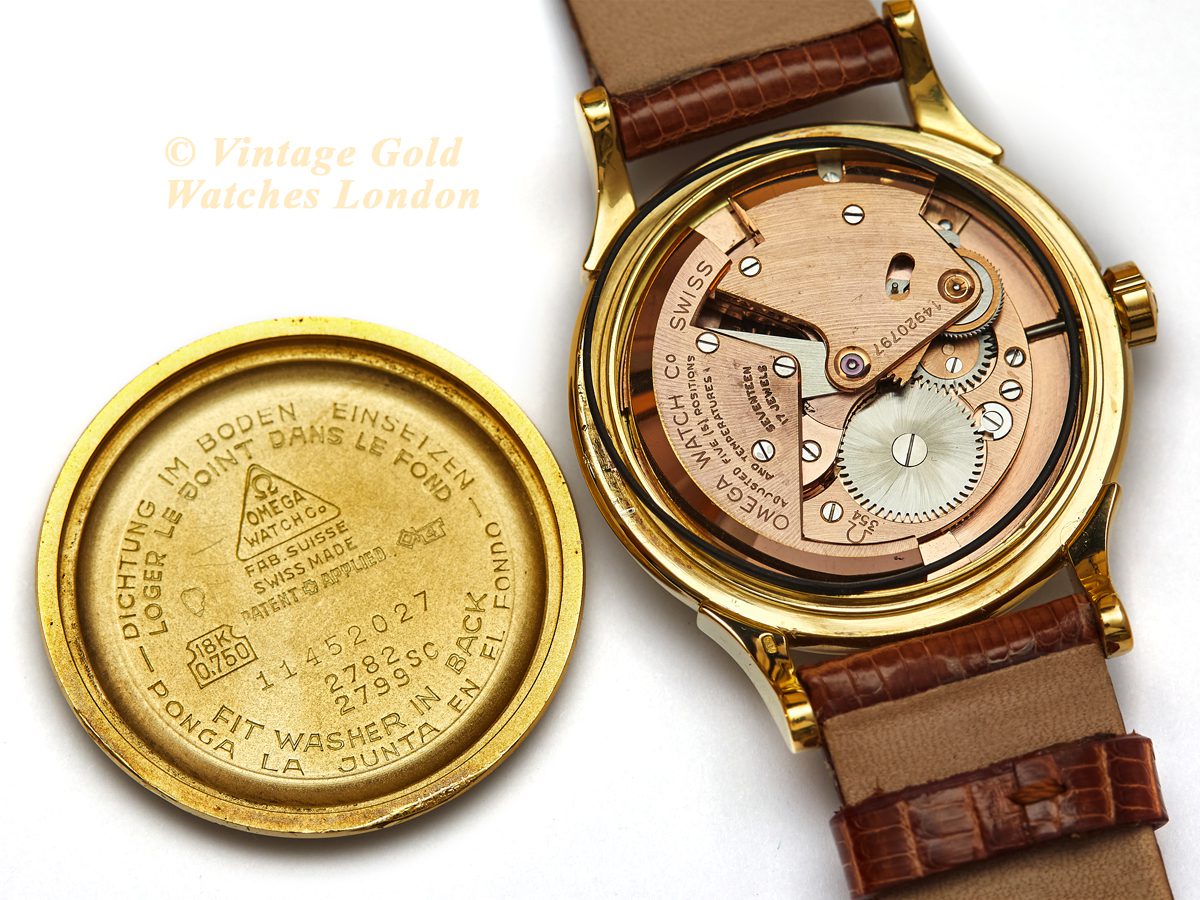
Movement and Serial Number: If possible (during an in-person purchase, or if the seller provides photos of the movement), check that the caliber corresponds correctly to the reference and that its appearance is authentic. Pie Pan Constellations all have chronometer calibers (35x, 50x, 55x, or 75x series). A non-chronometer Omega movement (e.g., caliber 550 or 552) has no place in a Constellation – it would be a Franken (replaced movement). Likewise, a caliber that is too modern (e.g., 564 in a watch supposed to date from 1962, thus before the introduction of this caliber) would be anachronistic. The movement’s serial number can also help date the year of production and check consistency with the reference. For example, a number in the 17 million range corresponds to around 1959-60, 20 million around 1963, 24 million around 1966-68, etc. If the number series is far off (a discrepancy of 5 years or more compared to the known period of the model), be cautious. Finally, ensure the movement bears the inscription “Adjusted [to] Five Positions and Temperature” and “Chronometer” on the plate: Omega chronometer calibers were engraved this way. An absence of the chronometer mention on the movement of a Constellation is a deal-breaker.
In summary, to thwart the traps of fake Constellations, one must observe every detail: the sharpness of the dial and texts, the presence and quality of the appliques (Ω logo and star in relief), the consistency of the tritium, the correct shape of the hands and markers, the finishing of the case and medallion, and the movement/reference adequacy. Do not hesitate to compare with archival photos or seek the advice of online communities (Omega forums) in case of doubt: experienced collectors are well aware of the frequent errors in counterfeits. With a keen eye and these criteria in mind, you will avoid most pitfalls and be able to spot authentic Pie Pans worthy of interest.
Buying Tips for a Vintage Omega Constellation
Acquiring a vintage Omega Constellation – particularly a Pie Pan model from the 50s-60s – is an exciting project, but one that requires caution. Here are some recommendations for a successful purchase:
Where to find vintage Constellations? Sources are multiple. Online auction and sales platforms specializing in collector’s watches are a good starting point: for example Catawiki, eBay, Chrono24, or auctions by watch houses. Enthusiast forums (Omega Forums, Watchuseek) also host classified ads between members, often trustworthy. Finally, watch dealers and flea markets, watch fairs, or specialized antique dealers may offer Constellations, with the advantage of seeing the watch in person. Each channel has its advantages: online auctions offer a wide choice and sometimes good deals, while professional sellers often provide a guarantee of operation and authenticity (but with a corresponding price).
Rarity and Availability: Constellations from the 50s-60s are not ultra-rare watches – Omega produced a large number of them – but finding an example in good original condition is becoming increasingly difficult. The most common models on the second-hand market are often in steel or gold-plated steel, with silvered dials. Rarer (and more expensive) variants include original black dials (less common, beware of redials)


